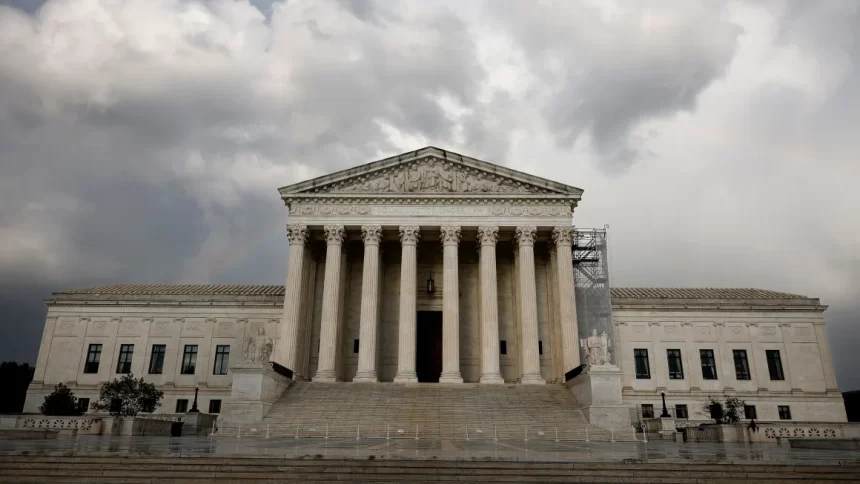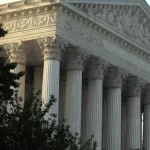Less than a month ago, Justice Elena Kagan suggested the Supreme Court consider dialing back its review of significant cases on its controversial emergency docket.
“Our summers used to be actually summers,” Kagan told a group of judges in California, lamenting the “relentless” filing of emergency appeals. “We’ve gotten into a pattern where we’re doing too many of them.”
Since then, the Supreme Court’s emergency caseload has exploded.
Thursday, the court declined to revive parts of a Republican-backed Arizona law that could have barred thousands of voters from casting a ballot in the November presidential contest or voting by mail. In the coming days, the high court is also expected to tackle short-fuse challenges to President Joe Biden’s latest effort to reduce student debt and to cut planet-warming pollution by limiting power plant emissions. Also pending is a fight over Biden’s requirement that family planning clinics that receive federal public health funding provide referrals for abortions for patients who request it.
The court’s emergency docket – the “shadow docket,” to critics – is where the justices deal with questions that need resolution faster than the months it can take to submit briefs, hear oral arguments and draft formal opinions on its regular docket.
The cases usually deal with the narrow question of what will happen as that underlying legal process plays out. But the orders can have significant and immediate real-world consequences.
“There’s just no disputing that this has been a busier summer for emergency applications, both by volume and by significance, than any summer we’ve seen in a long time – if ever,” said Steve Vladeck, a CNN Supreme Court analyst and professor at the Georgetown University Law Center, who says the court is essentially inviting these cases by issuing emergency rulings with more impact.
“It seems pretty clear that there’s a disconnect between the justices’ public comments expressing concern and their behavior when these applications reach them,” said Vladeck, who wrote a book on the issue, “The Shadow Docket: How the Supreme Court Uses Stealth Rulings to Amass Power and Undermine the Republic.”
“Given that the court continues to grant emergency relief in contexts in which it didn’t until recently – and given that there’s virtually no downside to seeking emergency relief – it’s effectively open season for aggressive lawyers,” he said.
Court rejects transgender protections
In all, there are 18 emergency cases waiting for an answer from the high court – though 13 of those raise three substantially similar legal questions.
Even if no additional emergency applications land this summer, Vladeck says, the court is already on track to exceed its caseload of the past several summers – including in 2020, when the justices juggled a string of controversial Covid-19-related cases.
The court’s latest emergency order landed Friday, when the justices blocked a Biden administration proposal to shore up civil rights protections for transgender and pregnant students. The new rule, challenged by 10 conservative states, would bar discrimination on the basis of a student’s gender identity.
Combined with a series of lower court decisions, the rule is now on hold in about half the country.
A brief, unsigned order issued by the Supreme Court explained some of the rationale for that decision – the court couldn’t separate the controversial provisions from others that weren’t directly challenged. But critics said the breezy, three-page opinion would likely only sow further confusion.
Justice Sonia Sotomayor, the court’s senior liberal, slammed the “overly broad” ruling, writing in a partial dissent joined by three others that the outcome “deprived” residents in the states that sued “guidance related to their rights.”
The court appeared to send the opposite signal just four months ago. In a case dealing with Idaho’s strict ban on gender-affirming care, the court allowed the state to temporarily enforce the law. Three conservative justices complained that lower courts had imposed a far more sweeping order than necessary – the exact argument the court found unpersuasive in the case of Biden’s rule.
Perhaps underscoring the thorny and often politically heated questions in play on the emergency docket this month, the court has at times been slow to resolve the disputes.
Since mid-2023, the court has needed about 20 days, on average, to resolve significant emergency cases – not including those involving capital punishment – according to a CNN analysis. But it took the justices 25 days to resolve a recent emergency challenge over Biden’s transgender rule.
It’s been 29 days since West Virginia filed the first of several appeals seeking to halt Biden’s power plant rules.
In that case, Republican states and industry groups are challenging an Environmental Protection Agency rule that would compel existing coal and new natural gas power plants to either cut or capture 90% of their climate pollution by 2032. A decision in that case could come as soon as this week.
Biden’s student debt plan in jeopardy – again
The Department of Education, meanwhile, has asked the justices to lift a court order blocking a Biden plan to slash monthly student loan payments and quicken the path to forgiveness – a central promise of his 2020 presidential campaign. A decision in that case could also come within days.
And in a case likely to be resolved in coming days, the Republican Party has asked the high court to allow Arizona to enforce a requirement that residents registering to vote for president to document their US citizenship. The case is likely to be one of many election matters to make its way to the Supreme Court amid a historic presidential election. Former President Donald Trump and other Republicans have falsely claimed widespread voting by immigrants in the country illegally.
It’s possible the Supreme Court will move some of the pending disputes to its regular, merits docket when the court reconvenes in October for a new nine-month term, scheduling arguments and handing down formal opinions.
In recent years, some of the court’s biggest cases originated on the emergency docket.
In June, for instance, the court handed down a 5-4 decision halting a Biden environmental rule intended to reduce smog and air pollution in a case that arrived on the shadow docket.
But while the practice of moving the emergency cases to the regular docket has picked up in recent years – and is widely seen as a response to criticism – it can have drawbacks.
Speaking at a judicial conference in Sacramento in late July, Kagan suggested that the court may have acted too hastily when it took up a request from Idaho to allow it to enforce a Biden administration rule requiring emergency rooms to perform abortions when the health of the pregnant woman is at stake. By the time it reached the Supreme Court for argument the facts of the case – usually developed by lower courts – were unclear.
In late June, the court handed the issue back to lower courts, punting for now on a review of the underlying legal questions raised.
Although some of the justices may be hesitant to resolve the emergency cases before the questions involved have been fully figured out, there are times when it must, Kagan said. That’s especially true in situations in which a lower court has blocked a law or policy nationwide.
“It’s a very difficult question as to how exactly we should approach these ever-increasing number of emergency petitions,” she said. “But more and more it’s not only the argued cases, but that work that is the Supreme Court’s docket.”










